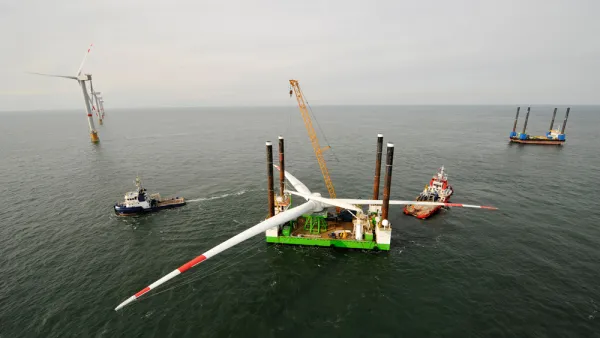Last week the foundations for five wind turbines were towed into place off Block Island, 13 miles east of Rhode Island in the Atlantic Ocean. Scheduled to go online in 2016, they will be the first offshore wind turbines in the United States.
While the 30 megawatt, five-turbine Block Island Wind Farm may pale in comparison to the 130 turbines planned for Cape Wind in Nantucket Sound, a project that has received far greater attention but remains stalled, the importance of this event can not be overstated. Construction began Monday, reports Maritime Executive.
"It’s a moment that its supporters have long anticipated, billing it as nothing less than the dawn of a new clean energy future for the United States, which lags Europe and China in harnessing ocean gusts for electricity," writes Diane Cardwell, Business Day reporter for The New York Times, on what will be "the nation’s first commercial-scale offshore wind farm."
Deepwater Wind, the company that is developing the farm, is pressing ahead. It holds a 30-year lease on a parcel in federal waters nearby — about 256 square miles about 15 miles southwest of Martha’s Vineyard — with room for as many as 250 turbines.
In addition to that site, known as Deepwater One, the company has plans for a site off the New Jersey coast, known as Garden State Offshore Energy, for 200 turbines generating one gigawatt of energy. That project should not be confused with the much smaller Fishermen’s Energy project off the Jersey coast that remains stalled.
For the United States to catch up to other countries like Denmark, which opened the world's first offshore wind farm in 1991, "stable subsidies and mandates — and coordination among the states," will be required, warned policy experts and business executives, or "offshore wind development will be limited to a few small demonstration projects," writes Cardwell.
FULL STORY: Offshore Wind Farm Raises Hopes of U.S. Clean Energy Backers

National Parks Layoffs Will Cause Communities to Lose Billions
Thousands of essential park workers were laid off this week, just before the busy spring break season.

Retro-silient?: America’s First “Eco-burb,” The Woodlands Turns 50
A master-planned community north of Houston offers lessons on green infrastructure and resilient design, but falls short of its founder’s lofty affordability and walkability goals.

Delivering for America Plan Will Downgrade Mail Service in at Least 49.5 Percent of Zip Codes
Republican and Democrat lawmakers criticize the plan for its disproportionate negative impact on rural communities.

Test News Post 1
This is a summary

Test News Headline 46
Test for the image on the front page.

Balancing Bombs and Butterflies: How the National Guard Protects a Rare Species
The National Guard at Fort Indiantown Gap uses GIS technology and land management strategies to balance military training with conservation efforts, ensuring the survival of the rare eastern regal fritillary butterfly.
Urban Design for Planners 1: Software Tools
This six-course series explores essential urban design concepts using open source software and equips planners with the tools they need to participate fully in the urban design process.
Planning for Universal Design
Learn the tools for implementing Universal Design in planning regulations.
EMC Planning Group, Inc.
Planetizen
Planetizen
Mpact (formerly Rail~Volution)
Great Falls Development Authority, Inc.
HUDs Office of Policy Development and Research
NYU Wagner Graduate School of Public Service



























